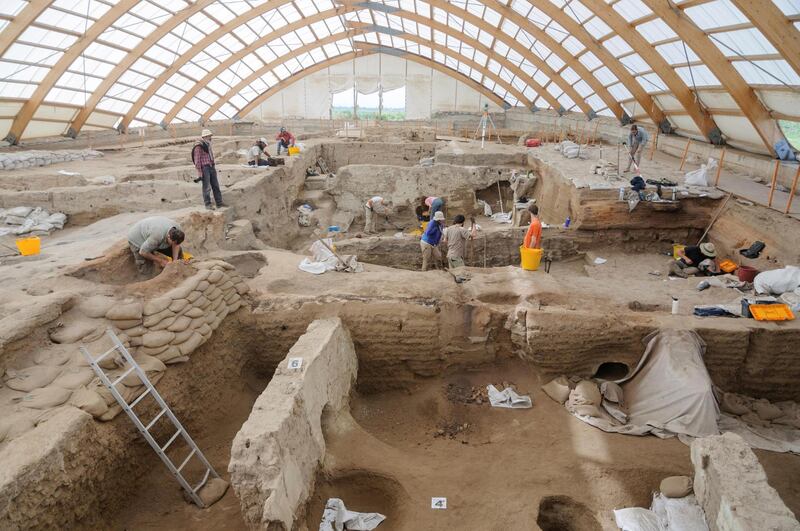My neighbourhood recently got new bins. The ones with black tops are for regular waste, while the ones with green tops are for recyclables. A few days ago, I was furious when I noticed that someone on my street had been putting regular rubbish in the recycling bins.
Given current global concerns about the environment, who could be so thoughtless? Shaking my head, I deposited my rubbish in the correct receptacle, and momentarily dismissed the modern world as a lost cause.
However, it turns out that the trials of urban living are not so modern at all. An archaeological research study – published last week in the ponderously named Proceedings of the National Academy of Sciences of the United States of America, and reported on by newspapers including The National – describes life in Çatalhöyük, one of the world's earliest proto-urban communities.
Founded around 9,000 years ago, Çatalhöyük is often referred to as “the world’s first city”. Located in modern-day Turkey, it was home to about 8,000 people at its peak, and the problems they experienced sound surprisingly familiar.
One of the main issues the population faced centred on sanitation and what to do with waste. In Çatalhöyük, the rubbish pits and animal pens sat alongside the houses – an urban planning faux pas likely to have contributed to the spread of infectious diseases. Looking at the skeletal remains of Catalhoyuk’s inhabitants, this new study found that the bones of up to one-third of those examined showed evidence of infection.
Waste disposal remains a massive problem for us today. For example, research published in 2016 in the International Journal of Epidemiology found that living within 5km of a landfill site was associated with an elevated risk of severe respiratory diseases, including lung cancer.
Earlier this year, 187 countries signed a historic agreement giving nations the power to block the importation of contaminated or hard-to-recycle plastic refuse. The idea behind the treaty is to prevent wealthier nations from dumping plastics on poorer countries, a practice with serious health implications for recipient nations.
Another issue faced by inhabitants of Catalhoyuk was overcrowding. As the population grew, so did the demand for food and building materials. The archaeological evidence shows differences in the leg bones of earlier and later generations, suggesting that the latter had to do more walking. More people meant more effort – for example, having to travel further from home to find building materials or graze livestock.
The number of people per square kilometre can still be an issue in today’s societies. For a start, numerous research studies report a relationship between the prevalence of severe mental health problems and increased population density.
Big-city life can be stressful. The mud-brick houses at Catalhoyuk were built like apartments with adjoining walls and no spaces between each unit. Entry and exit were through the roof, meaning that some inhabitants potentially had noisy neighbours on all four sides.
As the population grew, there seems to have been no shortage of violence. From a sample of 93 skulls, a quarter of them had sustained head injuries consistent with a violent attack, and more than half of the victims were women.
Violence remains a problem in many urban centres, with some regions faring far worse than others. While cities such as Abu Dhabi and Dubai consistently rank among the safest in the world, North and South American cities dominate the per capita murder rate rankings. In her book Evil Genes, the author Barbara Oakley argues that larger urban areas provide a perfect environment for such crimes. In a small village hundreds of years ago, for example, antisocial acts might have got you banished for life, whereas in the modern metropolis, it is much easier to act inappropriately and fade back into the mass of humanity.
The final downfall of Çatalhöyük, however, wasn’t violence or interpersonal conflict. It was climate change and environmental degradation. There is evidence that, over time, the mud taken from the nearby river caused the waterway to alter its course, disturbing local ecosystems. It also appears that deforestation and large-scale grazing had a detrimental impact. The population at Catalhoyuk declined rapidly, and the site was abandoned after almost 2,000 years of continuous habitation.
The lead author of the latest Catalhoyuk study and professor of anthropology at Ohio State University, Clarke Larsen concludes that “many of the challenges we have today are the same ones they had in Catalhoyuk – only magnified”.
Humanity has been working to develop and refine the concept of the city for close to 10,000 years. We have a long way to go before we perfect it. However, take a walk down the busy streets of Abu Dhabi or Dubai, and it quickly becomes apparent that this is a project that is still well worth pursuing. Filled with people from across the globe, working side by side to build better lives for themselves and their families, socialising and making new friendships, cities show us that the benefits of large-scale co-operation and community far outweigh the pitfalls – especially if neighbours can work out how to recycle properly.
Justin Thomas is a professor of psychology at Zayed University





